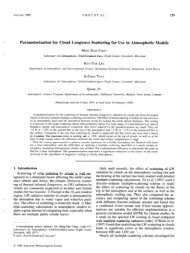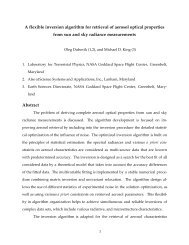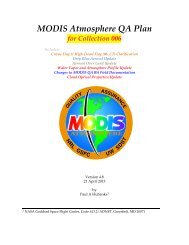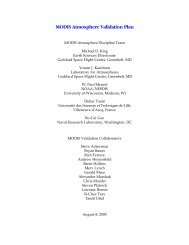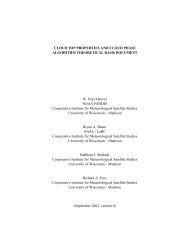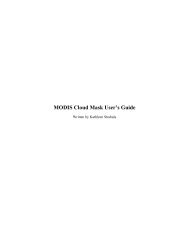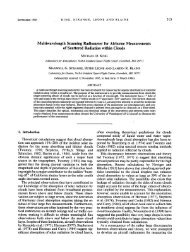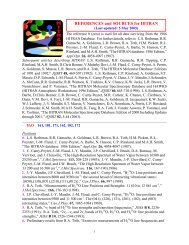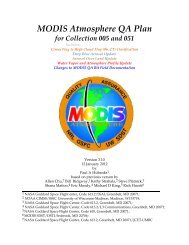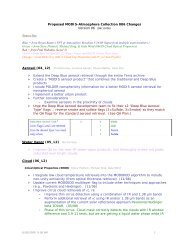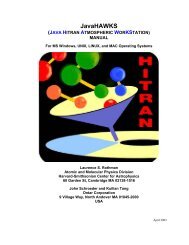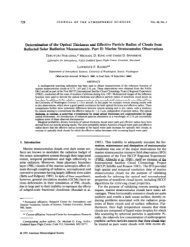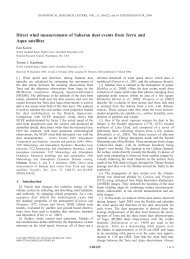King et al. (1993) - MODIS Atmosphere - NASA
King et al. (1993) - MODIS Atmosphere - NASA
King et al. (1993) - MODIS Atmosphere - NASA
You also want an ePaper? Increase the reach of your titles
YUMPU automatically turns print PDFs into web optimized ePapers that Google loves.
JOURNAL OF GEOPHYSICAL RESEARCH. VOL. 9X. NO. D2, PAGES 2719-2739, FEBRUARY 20, <strong>1993</strong><br />
Optic<strong>al</strong> Properties of Marine Stratocumulus Clouds Modified by Ships<br />
MICHAEL D. KING<br />
LAWRENCE F. RADI(E’ ANU PETER V. HOBBS<br />
The angular di\tr-ibution of \cattered radiation deep within a cloud layer was measured in marine<br />
stratocumulu\ clouds modified by the emissions from \hip\. These observations, obtained at I3<br />
discr<strong>et</strong>e wavelengthx b<strong>et</strong>ween 0.5 and 2.3 pm. were acquired as the UniverGty of Washington C-l3lA<br />
aircraft flew through ;L pair ot’ rotlphly par<strong>al</strong>lel \hip tr-ack jignatures produced in clouds off the coast of<br />
southern C<strong>al</strong>ifornia on July IO. 19x7. In the first of these ship track\. the nadir (upwelling) intensity<br />
increased from 40 to I IO W mm2 pm ’ sr- ’ a1 0.734 pm. The second ship track produced a less<br />
dramatic. but mol-e uniform, increa:gt in ‘h-c, up\\elling intensity. In contrast. the nadir intgnsity-yt Z.‘(/<br />
pm decreased from I to 0.13 W m - pm \r ’ in the first ship track and to 0.6 W m - pm sr<br />
in the second \hip track. The relative angular distribution of the intensity field at each wavelength was<br />
u,ed to d<strong>et</strong>ermine the similarity param<strong>et</strong>er. and hence single scattering <strong>al</strong>hedo, of the cloud using the<br />
difl‘usion domain m<strong>et</strong>hod. Beside, the spectr<strong>al</strong> similarity param<strong>et</strong>er, the\e measurements provide a<br />
good estimate of the optic<strong>al</strong> depth of the cloud layer both above and below the aircraft. Results of this<br />
an<strong>al</strong>ysi\ are presented for a 1%km section of marine stratocumulus cloud including both ship tracks.<br />
This an<strong>al</strong>ysis shows that the tot<strong>al</strong> optic<strong>al</strong> thickness of the cloud layer increased in the ship tracks, in<br />
contrast to the similar-ity param<strong>et</strong>er which decreased. The decrease in absorption was a direct<br />
consequence of the reduction in cloud dropl<strong>et</strong> size that occurred within the ship tracks.<br />
The conclusions which may be drawn from these experiments<br />
are-( I) that when water vapour condense5 in the atmosphere.<br />
it <strong>al</strong>ways does ‘ro on some solid nucleus: (2) that the dust<br />
particles in the air form the nuclei on which it condenses: (3) if<br />
there wa\ no dust in the air there would be no fogs. no clouds.<br />
no mists, and probably no rain.<br />
J. Aitken (18X0)<br />
The concentrations of cloud dropl<strong>et</strong>s in stratiform clouds<br />
are thought to be primarily a function of the concentrations<br />
of cloud condensation nuclei (CCN) at a few tenths of I%<br />
supersaturation [T~c~orr~c,~. 1959; T~wm~ u/rd Wrrrtter. 19671.<br />
The effect of natur<strong>al</strong> and anthropogenic aerosol on cloud<br />
structure, cloud chemistry, and solar radiation is an active<br />
area of research [e.g., 7’~twtne.v. 1980; Hrdsott. 1983; Radk.<br />
19891. In the remote marine environment, dim<strong>et</strong>hylsulfide<br />
produced by phytoplankton is believed to be the major<br />
source of CCN after oxidation to form sulfate aerosol [Sigg<br />
<strong>et</strong> (I/., 1984; Ayers rt (11.. 1991: lirgl: <strong>et</strong> (11.. 19911. Anthro-<br />
pogenic sources of pollution can <strong>al</strong>so atfect CCN concentrations<br />
and cloud dropl<strong>et</strong> size distributions as shown downwind<br />
of cane fires in Austr<strong>al</strong>ia [Wnrttrr trtzd Tuvttwy, 19671,<br />
paper mills in the Pacific Northwest [Hobbs <strong>et</strong> r/l., 19701,<br />
urban cities such as Denver and St. Loui\ (Sqtrircs, 1966:<br />
Bra/tam, 19741, and the eastern heaboard of the llnited<br />
States [Rrrdhc cttztl Hohh.s, 19761. Increases in anthropogenic<br />
sources of CCN over continents <strong>al</strong>-e expected to increase<br />
‘Now at iiation<strong>al</strong> Center for Atmospheric Research. Boulder,<br />
Colorado.<br />
Copyright <strong>1993</strong> by the American Geophysic<strong>al</strong> Union.<br />
Paper number 92JDOXX1.<br />
0148-0~17!93/925D-0’0X2$0~.00<br />
2729<br />
cloud <strong>al</strong>bedo by increasing the concentration and reducing<br />
the size of water dropl<strong>et</strong>s in low-level water clouds [T~zomeg<br />
<strong>et</strong> (I/. , 19841. Wixlex ( I9891 has argued that the large increase<br />
in SO2 emissions that has occurred in the northern hemi-<br />
sphere this century may have resulted in enhanced concen-<br />
trations of sulfate particles and hence CCN, thereby increas-<br />
ing cloud dropl<strong>et</strong> concentrations and in that way producing<br />
clouds with higher <strong>al</strong>bedos in the northern hemisphere than<br />
in the southern hemisphere. This suggestion is consistent<br />
with lltrrhec~‘s 119901 an<strong>al</strong>ysis of 3 years of AVHRR satellite<br />
observations over the Pacific Ocean, which shows that the<br />
aerosol optic<strong>al</strong> thickness and cloud reflectance at 3.7 pm are<br />
both approximately twice as large in the northern hemi-<br />
sphere as in the southern hemisphere.<br />
A striking example of the effects of anthropogenic CCN on<br />
cloud radiative properties can be found in satellite observa-<br />
tions of marine stratocumulus clouds modified by emissions<br />
from ships. These so-c<strong>al</strong>led “ship tracks” in clouds were<br />
first observed in satellite imagery under conditions in which<br />
exhaust particles emitted by ships were responsible for<br />
producing a visible cloud in otherwise cloud-free conditions<br />
as deduced by satellite [Cotmw, 19661. Coul\ley <strong>et</strong> <strong>al</strong>. [1987]<br />
and Alhtwht [ I9891 further noted the frequent and long-lived<br />
occurrence of ship track signatures in preexisting stratus and<br />
stratocumulus clouds, as evident by the enhanced reflec-<br />
tance of the clouds produced by exhaust from these ships,<br />
especi<strong>al</strong>ly at 3.7 pm [see Scorer, 19871. During the marine<br />
stratocumulus intensive field observation (IFO) component<br />
of the First ISCCP Region<strong>al</strong> Experiment (FIRE), conducted<br />
off the coast of southern C<strong>al</strong>ifornia during July 1987 [Al-<br />
hrcc.ht <strong>et</strong> rll., 19881, we obtained the first in situ microphysics<br />
and solar radiation measurements of clouds modified by<br />
pollution from ships. Selected radiative and microphysic<strong>al</strong><br />
properties of these clouds, tog<strong>et</strong>her with AVHRR satellite<br />
images. were previously described by Rrdke <strong>et</strong> ~1. [1989].
2730 KING ET AL.: OFWCAL PROPERTIES OF CLOUDS MODIFIED BY SHIPS<br />
Fig. 1. GOES 6 visible image for 1615 UTC (0915 PDT) on July IO, 1987. The image encompasses the FIRE marine<br />
stratocumulus region and includes the flight track of the C-131A aircraft b<strong>et</strong>ween 0850 and 0915 PDT. The arrows<br />
indicate the pair of roughly par<strong>al</strong>lel ship tracks pen<strong>et</strong>rated by the aircraft.<br />
In this paper, we present intern<strong>al</strong> scattered radiation<br />
measurements at selected wavelengths b<strong>et</strong>ween 0.5 and 2.3<br />
pm that were obtained in the same 120-km section of marine<br />
stratocumulus clouds containing these two ship track fea-<br />
tures. The angular distribution of scattered radiation in a<br />
vertic<strong>al</strong> plane on the right-hand side of the aircraft was<br />
measured aboard the University of Washington’s Convair<br />
C- 13 1A research aircraft using the cloud absorption radiom-<br />
<strong>et</strong>er (CAR) described by <strong>King</strong> <strong>et</strong> <strong>al</strong>. [1986]. In addition to the<br />
radiation measurements, the cloud microphysic<strong>al</strong> structure,<br />
including cloud dropl<strong>et</strong> size distribution and liquid water<br />
content, were monitored continuously with instruments<br />
aboard the aircraft. Fin<strong>al</strong>ly, we present the optic<strong>al</strong> thickness<br />
and spectr<strong>al</strong> absorption of the cloud layer derived from<br />
scattered solar radiation measurements using the diffusion<br />
domain m<strong>et</strong>hod [<strong>King</strong>, 1981; <strong>King</strong> <strong>et</strong> <strong>al</strong>., 19901.<br />
2. SUMMARY OF OBSERVATIONS<br />
Measurements of the radiative and microphysic<strong>al</strong> proper-<br />
ties of clouds modified by the emissions from ships were<br />
obtained off the coast of southern C<strong>al</strong>ifornia on July 10,<br />
1987, as part of the FIRE IF0 program [Radke <strong>et</strong> <strong>al</strong>., 19891.<br />
On this day the C-131A aircraft was flying within a marine<br />
stratocumulus cloud layer about 400 m thick enroute to a<br />
coordinated mission with the <strong>NASA</strong> ER-2 aircraft when it<br />
encountered two anom<strong>al</strong>ous regions of cloud, each approx-<br />
imately 10-15 km in width, that exhibited substanti<strong>al</strong> differ-<br />
ences in cloud radiative and microphysic<strong>al</strong> properties from<br />
the surrounding cloud. Figure 1 illustrates a GOES 6 visible<br />
image of marine stratocumulus cloud obtained at 1615 UTC<br />
(0915 PDT) on July 10. Superimposed on this figure is the<br />
location of the C-131A flight track b<strong>et</strong>ween 0850 and 0915<br />
PDT. As is common for marine stratocumulus clouds of the<br />
eastern Pacific, these clouds were under the influence of a<br />
high-pressure system centered near 35”N, 14O”W, which<br />
produced a cloud pattern <strong>al</strong>igned with the boundary layer<br />
winds from the north. The bright lines of clouds b<strong>et</strong>ween<br />
33S”N, 121.O”W and 32.5”N, 120.5”W are the two anom<strong>al</strong>ous<br />
cloud regions referred to above, which were pen<strong>et</strong>rated by<br />
the aircraft at 0857-0859 and 0905-0908 PDT. A correspond-<br />
ing image obtained with the NOAA 10 AVHRR at 0838 PDT<br />
can be found in the work by Radke <strong>et</strong> <strong>al</strong>. [ 19891. We attribute
these two anom<strong>al</strong>ous regions of cloud to ship tracks, as<br />
described below.<br />
3. CLOUD MICROPHYSICAL MEASUREMENTS<br />
The University of Washington C-131A research aircraft is<br />
well equipped for measuring cloud microphysic<strong>al</strong> properties.<br />
The primary instruments of interest to the present investi-<br />
gation of water clouds are: (1) a Johnson-Williams hot wire<br />
probe for measuring the cloud liquid water content, and (2)<br />
three Particle Measuring Systems Inc. (PMS) probes for<br />
measuring the cloud dropl<strong>et</strong> size distribution. These size<br />
distribution measurements were obtained using an FSSP-<br />
100, an OAP-200X cloud probe, and an OAP-200Y precipi-<br />
tation probe to cover the radius range from 1.4 to 2250 pm.<br />
D<strong>et</strong>ailed descriptions of these instruments can be found in<br />
the work by Knollenberg [1981].<br />
Plate 1 depicts the cloud dropl<strong>et</strong> size distribution as a<br />
function of distance <strong>al</strong>ong the flight track for measurements<br />
obtained within the stratocumulus cloud layer b<strong>et</strong>ween 0850<br />
and 0915 PDT on July 10, 1987. At the average ground speed<br />
of80ms-’ , this image corresponds to a flight distance of 120<br />
km. The aircraft was flying at an <strong>al</strong>titude of 725 m near the<br />
middle of the cloud layer, which was itself about 440 m thick<br />
as d<strong>et</strong>ermined by profile descent measurements obtained<br />
through a stratocumulus cloud layer some 130 km south and<br />
1 hour 50 min later than the ship track pen<strong>et</strong>ration. The<br />
measurements presented in Plate 1 were acquired with the<br />
FSSP-100 and OAP-200X, and extend the corresponding<br />
FSSP-only image that was presented by Radke <strong>et</strong> <strong>al</strong>. [1989].<br />
The concentrations of dropl<strong>et</strong>s measured with the OAP-<br />
200Y (r 2 150 pm) were gener<strong>al</strong>ly too sm<strong>al</strong>l to be significant<br />
and are therefore omitted from Plate 1.<br />
The ship track features centered near 38 and 78 km are<br />
readily apparent in Plate 1 as having an enhanced concen-<br />
tration of sm<strong>al</strong>l dropl<strong>et</strong>s, a reduced mode radius, a reduced<br />
concentration of drizzle-sized dropl<strong>et</strong>s (r 2 100 pm), and a<br />
narrower cloud dropl<strong>et</strong> size distribution. This reduction in<br />
the concentration of drizzle-sized dropl<strong>et</strong>s, first suggested by<br />
Albrecht [1989] and observed by Radke <strong>et</strong> <strong>al</strong>. [1989], can <strong>al</strong>so<br />
be seen in Figure 2, which contrasts the cloud dropl<strong>et</strong> size<br />
distribution in portions of the cloud affected by ships with<br />
corresponding portions of the cloud “uncontaminated” by<br />
ship track effluents. These results represent averages of<br />
measurements obtained using the FSSP-100 (squares) and<br />
OAP-200X cloud probe (circles), where the solid symbols<br />
correspond to the portions of the cloud affected by ships and<br />
the open symbols to uncontaminated cloud. The dropl<strong>et</strong> size<br />
distribution of the uncontaminated cloud has a larger con-<br />
centration of drizzle dropl<strong>et</strong>s than does the cloud affected by<br />
ships, a characteristic that was frequently observed during<br />
the FIRE marine stratocumulus IF0 [Albrecht, 1989; Radke<br />
<strong>et</strong> <strong>al</strong>., 19891.<br />
From measurements of the cloud dropl<strong>et</strong> size distribution<br />
it is straightforward to c<strong>al</strong>culate both the tot<strong>al</strong> concentration<br />
and effective radius of the cloud dropl<strong>et</strong>s, where the effective<br />
radius r, is defined by [Hansen and Travis, 19741:<br />
KING ET AL.: OPTICAL PROPERTIES OF CLOUDS MODIFIED BY SHIPS 2731<br />
re = 1: r3n(r) dr/[ r2n(r) dr, (1)<br />
where n(r) is the concentration of cloud dropl<strong>et</strong>s in the<br />
radius range r to r + dr. Figures 3 and 4 show the dropl<strong>et</strong><br />
concentration and effective radius as a function of distance<br />
(or time) for measurements obtained inside clouds b<strong>et</strong>ween<br />
0850 and 0915 PDT. These results, obtained from the size<br />
distribution measurements presented in Plate 1, clearly show<br />
the dramatic increase in dropl<strong>et</strong> concentration and decrease<br />
in effective radius in both regions of cloud affected by ships.<br />
These are just the effects to be expected from clouds<br />
modified by effluents from ships in otherwise pristine marine<br />
air. Figure 5 shows a corresponding time series of cloud<br />
liquid water content measured with the Johnson-Williams<br />
hot wire probe, and demonstrates that the liquid water<br />
content is substanti<strong>al</strong>ly enhanced in both ship track regions,<br />
as reported by Radke <strong>et</strong> <strong>al</strong>. [1989].<br />
The increased dropl<strong>et</strong> concentration, decreased particle<br />
size, and increased liquid water content that we observed in<br />
both ship track features that we pen<strong>et</strong>rated on July IO <strong>al</strong>l act<br />
in such a way as to increase the optic<strong>al</strong> thickness of the<br />
portions of the cloud affected by ships. This is consistent<br />
with the increased reflectance of the clouds <strong>al</strong>ong the ship<br />
tracks that we reported from AVHRR satellite imagery<br />
[Radke <strong>et</strong> a/., 19891, and which is apparent in the GOES 6<br />
visible image presented in Figure 1.<br />
4. RADIATION MEASUREMENTS<br />
In addition to cloud microphysic<strong>al</strong> properties, the C- 13 1A<br />
aircraft carries a cloud absorption radiom<strong>et</strong>er (CAR) devel-<br />
oped at Goddard Space Flight Center. This instrument, a<br />
13-channel scanning radiom<strong>et</strong>er mounted in the nose of the<br />
aircraft, scans in a vertic<strong>al</strong> plane from 5” before zenith to 5”<br />
past nadir (190” aperture) with an instantaneous field of view<br />
of 1”. This permits observations of the angular distribution of<br />
scattered radiation from zenith to nadir at 13 discr<strong>et</strong>e wave-<br />
lengths b<strong>et</strong>ween 0.5 and 2.3 pm with as much as a 5” roll of<br />
the aircraft. A d<strong>et</strong>ailed description of this instrument can be<br />
found in the work of <strong>King</strong> <strong>et</strong> <strong>al</strong>. [1986].<br />
Figures 6 and 7 illustrate the zenith and nadir intensities as<br />
a function of distance (time) for measurements obtained<br />
inside clouds for a 120-km section of the cloud studied on<br />
July 10, 1987. These data, corresponding to observations<br />
obtained with the cloud absorption radiom<strong>et</strong>er at 0.744 and<br />
2.20 pm, respectively, show that the zenith and nadir<br />
intensities were substanti<strong>al</strong>ly modified by the ships. At A =<br />
0.744 pm (Figure 6), for example, the upwelling (nadir)<br />
intensity increased from approximately 40 to 110 W mp2<br />
pm-’ sr -’ in the first ship track, with a somewhat less<br />
dramatic, though more uniform, increase in the second ship<br />
track. The downwelling (zenith) intensity, on the other hand,<br />
showed a modest decrease in both ship tracks. These<br />
changes are consistent with the fact that the tot<strong>al</strong> optic<strong>al</strong><br />
thickness of the cloud layer increased, and are a direct<br />
consequence of the observation that the tot<strong>al</strong> concentration<br />
and concentration of sm<strong>al</strong>l dropl<strong>et</strong>s increased, while the<br />
mean dropl<strong>et</strong> radius decreased.<br />
At A = 2.20 pm (Figure 7), both the upwelling (nadir) and<br />
downwelling (zenith) intensities decreased within the ship<br />
tracks. Again, the change is the most dramatic and the least<br />
uniform in the first ship track. The explanation for these<br />
changes can be understood as follows. As the optic<strong>al</strong> thick-<br />
ness increases, the addition<strong>al</strong> scattering leads to increased<br />
attenuation of solar radiation at this absorbing wavelength.<br />
The intensity distribution is thus reduced in <strong>al</strong>l directions<br />
within the cloud. This is not the case for reflected solar
60<br />
80<br />
KING ET AL.: OIWCAL PROPERTIES OF CLOUDS MODIFIED HY SHIPS<br />
Radius (pm)<br />
Ship Track<br />
# 1<br />
Ship Track<br />
# 2<br />
Plate 1. F<strong>al</strong>se color image of the cloud dropl<strong>et</strong> size distribution as a function of distance <strong>al</strong>ong I he Hif :ht path 1 ‘or a<br />
I? LO-km section of marine stratocumulus clouds on July IO, 1987. In both ship track features the *i-e is an enhar iced<br />
cc mcentration of sm<strong>al</strong>l dropl<strong>et</strong>s and a significant reduction of drizzle-sized dropl<strong>et</strong>s (r = IOO-pm r adiu\)<br />
103<br />
102<br />
10'<br />
100<br />
lo-'<br />
10-2<br />
10-a
10<br />
KING ET AL.: OITICAL PROPERTIES OF CLOUDS MODIFIED BY SHIPS 2733<br />
Radius (pm)<br />
Fig. 2. The average cloud drop size distribution in marine<br />
stratocumulus cloud affected by ships and in uncontaminated por-<br />
tions of the cloud on July 10, 1987. Note the reduced concentration<br />
of drizzle-sized dropl<strong>et</strong>s in the ship track-modified cloud layer<br />
compared to the uncontaminated portions of the cloud. The data<br />
points represent averages of measurements obtained with the PMS<br />
FSSP-100 (squares) and PMS OAP-200X cloud probe (circles). The<br />
solid symbols represent averages of <strong>al</strong>l size distribution measure-<br />
ments having an effective dropl<strong>et</strong> radius (re) in the range 7 5 rE 5<br />
8 km. whereas the open symbols pertain to distributions for which<br />
11 5 re 5 12 pm.<br />
radiation, since increasing the optic<strong>al</strong> thickness will <strong>al</strong>ways<br />
lead to an increased reflection function at <strong>al</strong>l wavelengths,<br />
provided the scattering layer (cloud) overlies a dark surface<br />
such as the Pacific Ocean.<br />
Figures 6 and 7 represent dramatic<strong>al</strong>ly different single<br />
scattering <strong>al</strong>bedos of the cloud layer. At A = 0.744 pm the<br />
150r. I I,’ /I’ I ’ 1 “’ 1<br />
40 60 80 100 120<br />
D~slance (km)<br />
Fig. 3. Cloud dropl<strong>et</strong> concentration as a function of distance<br />
<strong>al</strong>ong the flight track for measurements obtained inside clouds<br />
b<strong>et</strong>ween 0850 and 0915 PDT on July IO, 1987.<br />
0 20 40 60 80 100 120<br />
Distance (km)<br />
Fig. 4. As in Figure 3 except for the effective radius of the cloud<br />
drops.<br />
single scattering <strong>al</strong>bedo w0 = 1.0, whereas at A = 2.20 pm<br />
o. = 0.99 [cf. <strong>King</strong> <strong>et</strong> <strong>al</strong>., 19901. To examine the transition<br />
of the zenith and nadir intensities as the single scattering<br />
<strong>al</strong>bedo, and hence wavelength, varies, we have examined<br />
the nadir intensity (Figure 8) and zenith intensity (Figure 9)<br />
for selected wavelengths b<strong>et</strong>ween 0.744 and 2.20 pm. The<br />
curves for 0.744 and 2.20 pm are the same as those presented<br />
in Figures 6 and 7. For the nadir (upwelling) intensity (Figure<br />
8), the transition from an enhanced intensity at 0.744 pm to<br />
a reduced intensity at 2.20 pm is quite striking. At some<br />
wavelength b<strong>et</strong>ween I .20 and I .64 pm, these results suggest<br />
that the changes in the optic<strong>al</strong> properties of the cloud<br />
affected by ships would be imperceptible. The broadband<br />
pyranom<strong>et</strong>er measurements, which integrate over <strong>al</strong>l angles<br />
as well as the entire solar spectrum, follow very closely the<br />
changes that we observed with the CAR at 0.744 pm [cf.<br />
Radke <strong>et</strong> <strong>al</strong>., 19891.<br />
For the zenith (downwelling) intensity, illustrated in Fig-<br />
ure 9, the intensity decreases at <strong>al</strong>l wavelengths, though the<br />
reduction at 0.744 pm is extremely sm<strong>al</strong>l, as noted previ-<br />
ously in Figure 6. The effect of increasing absorption as the<br />
r<br />
00 L<br />
0 20 40 60 80 100 120<br />
Distance (km)<br />
Fig. 5. As in Figure 3 except for the cloud liquid water content.
2734 KING ET AL.: OPTICAL PROPERTIES OF CLOUDS MODIFIED BY SHIPS<br />
0’ 1 “’ “, 1 ” 1 ‘1’ I I<br />
0 a 40 60 80 100 120<br />
Distance (km)<br />
Fig. 6. Zenith and nadir intensities as a function of distance<br />
<strong>al</strong>ong the flight track for measurements obtained inside clouds<br />
b<strong>et</strong>ween 0850 and 0915 PDT. These measurements were obtained at<br />
a wavelength of 0.744 pm.<br />
wavelength increases is readily apparent in this figure as an<br />
increasingly large decrease in the transmitted intensity field,<br />
especi<strong>al</strong>ly evident in the ship track features. The broadband<br />
pyranom<strong>et</strong>er, which again reflects primarily the measure-<br />
ment at nonabsorbing wavelengths near 0.744 pm, shows<br />
that the downwelling flux was reduced slightly in the ship<br />
tracks, as anticipated from an examination of Figure 9.<br />
5. RESULTS FROM OBSERVATIONS<br />
Although the major changes in the intern<strong>al</strong> scattered<br />
radiation field within the ship track-modified marine strato-<br />
cumulus clouds can be explained by changes in cloud optic<strong>al</strong><br />
thickness, both above and below the aircraft, it is conceiv-<br />
able that soot particles from the ship exhaust could <strong>al</strong>so have<br />
a direct effect on the spectr<strong>al</strong> intensity field within the<br />
clouds. In fact, one might argue that, in addition to increas-<br />
ing optic<strong>al</strong> thickness by the emission of cloud condensation<br />
nuclei, the ship exhaust could lead to increased absorption<br />
by the cloud dropl<strong>et</strong>s. Two comp<strong>et</strong>ing effects are thus<br />
0 20 40 60 80 100 120<br />
Distance (km)<br />
Fig. 7. As in Figure 6 except for a wavelength of 2.20 pm.<br />
I<br />
0.1 1<br />
’ 1 ” ’ ” ’ ” 1<br />
0 20 40 60 80 100 120<br />
Distance (km)<br />
Fig. 8. Nadir (upwelling) intensities as a function of distance for<br />
measurements obtained inside clouds b<strong>et</strong>ween 0850 and 0915 PDT.<br />
These measurements were obtained at selected wavelengths be-<br />
tween 0.744 and 2.20 Wm.<br />
possible: (1) increased absorption from aerosols, either as a<br />
result of dirty water or interstiti<strong>al</strong> aerosol; and (2) decreased<br />
absorption because the cloud dropl<strong>et</strong>s are sm<strong>al</strong>ler.<br />
To assess the importance of these two effects on the ship<br />
track-modified clouds that we observed, we applied the<br />
diffusion domain m<strong>et</strong>hod to the radiation measurements<br />
presented in Figures 8 and 9. In this m<strong>et</strong>hod, described in<br />
d<strong>et</strong>ail by <strong>King</strong> <strong>et</strong> <strong>al</strong>. [1990], the intensity of scattered<br />
radiation deep within a cloud layer is measured as a function<br />
of zenith angle for selected wavelengths in the visible and<br />
near-infrared. To be applicable, therefore, the measure-<br />
ments must be obtained within the diffusion domain of an<br />
optic<strong>al</strong>ly thick medium, defined as a region sufficiently far<br />
from the top and bottom boundaries of the cloud such that<br />
the diffuse radiation field assumes an asymptotic form char-<br />
acterized by rather simple properties. In particular, the<br />
angular intensity distribution becomes azimuth<strong>al</strong>ly indepen-<br />
dent and monotonic<strong>al</strong>ly decreasing from zenith to nadir, with<br />
the relative angular distribution of scattered radiation being<br />
I . ’ ‘1’ 1” ’ v 1 “’ 1 1<br />
r...< ,... I I I ,.., I,!,,,! ,,I,,, 1<br />
0 20 40 60 80 100 120<br />
Distance (km)<br />
Fig. 9. As in Figure 8 except for zenith (downwelling) intensities.
TABLE 1. Spectr<strong>al</strong> Reflectance of the Pacific Ocean (Ag) on<br />
July 10, 1987<br />
Optic<strong>al</strong> Wavelength,<br />
Channel pm<br />
KING ET AL.: OPTICAL PROPERTIES OF CLOUDS MODIFIED BY SHIPS 2735<br />
Ocean<br />
Reflectance<br />
1 0.503 0.0742 k 0.0079<br />
2 0.673 0.0606 2 0.0076<br />
3 0.744 0.0634 k 0.0078<br />
4 0.866 0.0608 5 0.0078<br />
5 1.031 0.0555 f 0.0079<br />
6 1.198 0.0500 2 0.0082<br />
7 1.247 0.0542 ? 0.0085<br />
8 1.547 0.0432 2 0.0151<br />
9 1.640 0.0426 ?I 0.0086<br />
10 1.722 0.0389 k 0.0045<br />
11 1.996 0.0148 2 0.0165*<br />
12 2.200 0.0174 k 0.0120*<br />
13 2.289 0.0215 k 0.0097*<br />
*Adjusted to compensate for saturation of the transmitted inten-<br />
sity field in directions near the zenith.<br />
independent of the solar zenith angle and a strong function of<br />
the similarity param<strong>et</strong>er s, defined by<br />
SC<br />
l-w0<br />
~<br />
1’2<br />
i<br />
l-w@<br />
1<br />
’<br />
where g is the asymm<strong>et</strong>ry factor and w. the single scattering<br />
<strong>al</strong>bedo of a sm<strong>al</strong>l volume of cloud air.<br />
Using asymptotic theory for thick layers, <strong>King</strong> [I9811<br />
showed that the ratio of the nadir-to-zenith intensities within<br />
the diffusion domain of an optic<strong>al</strong>ly thick medium is solely a<br />
function of the surface reflectance (A,), similarity param<strong>et</strong>er<br />
(s), and sc<strong>al</strong>ed optic<strong>al</strong> depth b<strong>et</strong>ween the aircraft flight level<br />
and the base of the cloud [( 1 - g)(Tc - T)]. Since the<br />
measurements presented in Figures 6-9 were acquired over<br />
the Pacific Ocean some 300 km west of San Diego, the<br />
spectr<strong>al</strong> reflectance of the ocean surface was sm<strong>al</strong>l, quite<br />
uniform, and easy to characterize. We d<strong>et</strong>ermined A, for<br />
each channel of the CAR by assuming the transmitted<br />
intensity field beneath optic<strong>al</strong>ly thick clouds is azimuth<strong>al</strong>ly<br />
independent, thereby permitting us to integrate our transmit-<br />
ted intensity measurements over zenith angle to obtain<br />
estimates of the spectr<strong>al</strong> fluxes in the upward and downward<br />
hemispheres. Table 1 summarizes the spectr<strong>al</strong> surface reflec-<br />
tances and corresponding standard deviations obtained from<br />
this an<strong>al</strong>ysis for <strong>al</strong>l 13 channels of the CAR. Slight adjust-<br />
ments have been made for channels 11-13, since the trans-<br />
mitted intensity field experienced some saturation in the<br />
zenith direction in each of these channels.<br />
To d<strong>et</strong>ermine which measurements in Figures 6-9 are<br />
within the diffusion domain, we developed a comprehensive<br />
s<strong>et</strong> of tests to which the CAR data were subjected. These<br />
tests, described in d<strong>et</strong>ail by <strong>King</strong> <strong>et</strong> <strong>al</strong>. [ 19901, are based on<br />
the fact that the angular intensity field in the diffusion<br />
domain of an optic<strong>al</strong>ly thick, conservatively scattering me-<br />
dium varies as the cosine of the zenith angle (namely, Z(T,<br />
cos 0) = a + b cos 0). We have applied these criteria to<br />
channel 1 (A = 0.503 pm) of the CAR for each of the 2363<br />
scans presented in Figures 8 and 9, from which we conclude<br />
that 586 scans m<strong>et</strong> these criteria.<br />
Once the portions of a flight containing diffusion domain<br />
measurements have been identified, it is rather straightfor-<br />
ward to an<strong>al</strong>yze the measurements to derive the spectr<strong>al</strong><br />
(2)<br />
similarity param<strong>et</strong>er of the clouds using the diffusion domain<br />
m<strong>et</strong>hod. Before applying this m<strong>et</strong>hod to the experiment<strong>al</strong><br />
observations presented in Figures 8 and 9, it was first<br />
necessary to c<strong>al</strong>culate the relative optic<strong>al</strong> thickness and<br />
asymm<strong>et</strong>ry factor of water clouds as a function of wave-<br />
length for the cloud layer having the measured cloud dropl<strong>et</strong><br />
size distribution. Due to the large variability in cloud micro-<br />
physic<strong>al</strong> properties for this section of cloud, we found it<br />
necessary to subdivide the data into subsections for which<br />
the effective radius was relatively constant. We therefore<br />
chose to perform these single scattering c<strong>al</strong>culations for 14<br />
different size distributions, each of which represented an<br />
average of <strong>al</strong>l measured size distributions within an effective<br />
radius range of 1 pm (e.g., 7 5 r, < 8 pm). Figure 2<br />
illustrates two of these size distributions, one having an<br />
effective radius in the range 7 5 r, < 8 pm, characteristic of<br />
ship track contaminated clouds, and the other having r, in<br />
the range 11 5 re < 12 pm, characteristic of uncontami-<br />
nated clouds. The single scattering computations required a<br />
blend of Mie theory for size param<strong>et</strong>ers (2arlA) less that 100<br />
and complex angular momentum (CAM) theory [Nussenz-<br />
veig and Wiscombe, 19801 for size param<strong>et</strong>ers greater than<br />
100. The use of CAM theory permitted us to efficiently<br />
c<strong>al</strong>culate the spectr<strong>al</strong> optic<strong>al</strong> thickness and asymm<strong>et</strong>ry fac-<br />
tor for measured dropl<strong>et</strong> size distributions containing an<br />
appreciable number of large drizzle drops, drop sizes that<br />
would otherwise be prohibitively expensive to include in Mie<br />
theory computations.<br />
The sc<strong>al</strong>ed optic<strong>al</strong> depth b<strong>et</strong>ween the aircraft flight level<br />
and the base of the cloud was derived for each scan line of<br />
Figure 6 that satisfied the diffusion domain criteria. The<br />
lower curve in Figure 10 illustrates the optic<strong>al</strong> depth T, - T<br />
as a function of distance, where we converted sc<strong>al</strong>ed optic<strong>al</strong><br />
depth to optic<strong>al</strong> depth using the asymm<strong>et</strong>ry factor applicable<br />
to this wavelength (A = 0.744 pm). Of the 586 scan lines that<br />
passed our restrictive diffusion domain criteria, the vast<br />
majority were in the optic<strong>al</strong>ly thick regions containing ship<br />
track signatures and in the optic<strong>al</strong>ly thick region b<strong>et</strong>ween 100<br />
and 110 km that corresponds to the stratocumulus cellular<br />
40 60 80 100 120<br />
Distance (km)<br />
Fig. 10. Optic<strong>al</strong> depth as a function of distance <strong>al</strong>ong the flight<br />
track for <strong>al</strong>l measurements in Figure 6 that satisfy the diffusion<br />
domain criteria. The lower curve represents the optic<strong>al</strong> depth<br />
beneath the aircraft ( 7c - T) and the upper curve the tot<strong>al</strong> optic<strong>al</strong><br />
thickness of the cloud layer (TV). All results were derived from<br />
measurements at h = 0.744 pm.<br />
i
2736 KING ET AL.: OITICAL PROPERTIES OF CLOUDS MOIIIFIED BY SHIPS<br />
0.1<br />
o.oL. ” I “’ I L 1 “’ ’ ’<br />
0 20 40 60 60 100 120<br />
Distance (km)<br />
Fig. I I. Similarity param<strong>et</strong>er as a function of distance for four<br />
wavelengths b<strong>et</strong>ween 0.744 and 2.20 ym.<br />
region clearly evident in the GOES 6 visible image toward<br />
the end of the C-13 IA flight track (cf. Figure I). As expected,<br />
the ship track measurements b<strong>et</strong>ween 35 and 40 km corre-<br />
sponded to the region of cloud having the largest optic<strong>al</strong><br />
depth beneath the aircraft, since the angular intensity mea-<br />
surements obtained in this region of cloud were the most<br />
nearly isotropic of the measurements that we obtained (cf.<br />
Figure 6).<br />
Given the surface reflectance and optic<strong>al</strong> depth beneath<br />
the aircraft for an individu<strong>al</strong> scan of the radiom<strong>et</strong>er at a<br />
specified wavelength, the intensity ratio Z(T, - ~)/Z(T, 1) is<br />
reduced solely to a function of the similarity param<strong>et</strong>er s.<br />
Utilizing this relationship, described in d<strong>et</strong>ail by <strong>King</strong> <strong>et</strong> a/.<br />
[1990], we were able to c<strong>al</strong>culate the intensity ratio as a<br />
function of similarity param<strong>et</strong>er and match this function<strong>al</strong><br />
relationship with the measured intensity ratio to derive a<br />
v<strong>al</strong>ue of the similarity param<strong>et</strong>er for a given measurement<br />
and wavelength.<br />
Figure 11 illustrates the similarity param<strong>et</strong>er as a function<br />
of distance for four wavelengths of the CAR. This an<strong>al</strong>ysis is<br />
based entirely on the ratio of the nadir-to-zenith intensities<br />
obtained from the measurements presented in Figures 8 and<br />
9, and as such is entirely independent of the absolute<br />
c<strong>al</strong>ibration of the radiom<strong>et</strong>er. The decrease in the similarity<br />
param<strong>et</strong>er that we obtain within the ship track-modified<br />
cloud layer is a direct consequence of the fact that the<br />
effective radius of the cloud dropl<strong>et</strong>s decreased (cf. Figure<br />
4), since the similarity param<strong>et</strong>er s is proportion<strong>al</strong> to r:”<br />
[Twomey andBohren, 19801. These results are in no way due<br />
to a decrease in the imaginary part of the complex refractive<br />
index of the cloud dropl<strong>et</strong>s themselves. Due to the use of a<br />
filter wheel to measure the intensity field in channels 8-13,<br />
diffusion domain measurements were obtained in this time<br />
interv<strong>al</strong> for b<strong>et</strong>ween 71 and 79 scans, depending on filter<br />
position, in contrast to 586 scans for the first seven, simul-<br />
taneously sampled channels.<br />
Fin<strong>al</strong>ly, in order to d<strong>et</strong>ermine the optic<strong>al</strong> depth (7) above<br />
the aircraft, and hence the tot<strong>al</strong> optic<strong>al</strong> thickness (Tc) of the<br />
cloud layer, it is necessary to make use of the absolute<br />
intensity measurements in a particular direction (say nadir),<br />
in combination with the v<strong>al</strong>ues of 7,. - T, A, and s derived<br />
previously from relative intensity measurements. <strong>King</strong> <strong>et</strong> <strong>al</strong>.<br />
[1990] showed that in the diffusion domain of an optic<strong>al</strong>ly<br />
thick layer, the nadir (upwelling) intensity Z(T, - 1) can be<br />
written as<br />
z(T, -1) = s,P(l)r<br />
where<br />
SI =<br />
~oFo(l - &.A*)Kbo)<br />
~[(l - A,A*)(l - l’e-2kTc) + A,mn21e-2”‘C]’<br />
In these expressions, k is the diffusion exponent (eigenv<strong>al</strong>ue)<br />
describing the vertic<strong>al</strong> attenuation of radiation in the diffu-<br />
sion domain, P(u) the diffusion pattern (eigenfunction), u<br />
the cosine of the zenith angle with respect to the positive 7<br />
direction (- 1 5 N 5 l), p. the cosine of the solar zenith<br />
angle, F. the incident solar flux, K(po) the escape function,<br />
s, the strength of the diffusion stream in the positive 7<br />
direction, A* the spheric<strong>al</strong> <strong>al</strong>bedo of a semi-infinite atmo-<br />
sphere, D the diffusion pattern ratio P( - l)/P( l), and m, n,<br />
and 1 constants.<br />
All six asymptotic constants that appear in these expres-<br />
sions [A*, D, m, n, I, and kit 1 - g)] may be accurately<br />
represented by a function of the similarity param<strong>et</strong>er s, as<br />
demonstrated by <strong>King</strong> [ 19811. Thus, from our an<strong>al</strong>ysis of s at<br />
0.744 pm, obtained by applying the diffusion domain m<strong>et</strong>hod<br />
to relative intensity measurements (cf. Figure 1 l), it is rather<br />
straightforward to c<strong>al</strong>culate the asymptotic constants arising<br />
in (3) and (4) using the similarity relations given by <strong>King</strong> <strong>et</strong><br />
<strong>al</strong>. (19901. The diffusion pattern P(l) can be estimated by<br />
noting that when s is sm<strong>al</strong>l, as it is for h = 0.744 pm, the<br />
diffusion pattern P(u) = a + bu, the assumption for the<br />
angular distribution of scattered radiation in the Eddington<br />
approximation. Hence, by combining the definition of D =<br />
P( - l)/P( 1) with the definition of m, given by<br />
it can readily be shown that P( 1) can be approximated by the<br />
expression:<br />
3m<br />
P(1) =<br />
2(1 +D)(l<br />
[<br />
-D) ’<br />
I/?<br />
1<br />
which can readily be ev<strong>al</strong>uated using the similarity relations<br />
form and D.<br />
The solar zenith angle B. decreased from 56.7” at the<br />
beginning of the time series (0850 PDT) to 52.6” at the end<br />
(0915 PDT). For sm<strong>al</strong>l absorption the escape function K(pO)<br />
can be related to the escape function for conservative<br />
scattering KO(po), which itself is very nearly a linear func-<br />
tion of p. [van de H&t, 19801. For anisotropic cloud phase<br />
functions appropriate to water clouds at visible wavelengths,<br />
it is therefore sufficient to approximate K(pLO) as follows:<br />
K(pO) = (1 - q,k)(0.4384 + 0.8529/1.,,), (6)<br />
where q. is the extrapolation length. It is sufficiently accu-<br />
rate to approximate the reduced extrapolation length q’ =<br />
(1 - g)qo by 0.714 [<strong>King</strong>, 19811. Substituting these expres-<br />
sions and v<strong>al</strong>ues into (3) and (4), we were thus able to<br />
(4)
KING ET AL.: OFTICAL PKOPEKTIES OF CLOUDS MODIFIED BY SHIPS 2737<br />
TABLE 2. Optic<strong>al</strong> and Microphysic<strong>al</strong> Properties of Marine Stratocumulus Clouds Modified by<br />
Emissions From Ships<br />
Distance<br />
Microphysic<strong>al</strong> properties<br />
N, cmm3<br />
rp. I*m<br />
W.gmm3<br />
Optic<strong>al</strong> properties<br />
T< - 7<br />
s<br />
g<br />
WO<br />
Ship Track<br />
Uncontaminated<br />
Cloud Ship Track Ship Track<br />
38 km 63 km 74 km 82 km<br />
!04 41 12.5 137<br />
9.7 10.3 7.6 6.9<br />
0.72 0.30 0.51 0.46<br />
67.3<br />
44.7<br />
0.0335<br />
0.8577<br />
0.99984<br />
All optic<strong>al</strong> properties apply at A = 0.744 ym<br />
compute T,. (and hence 7) as a function of flight track<br />
distance.<br />
Figure 10 illustrates the tot<strong>al</strong> optic<strong>al</strong> thickness (T,.) as well<br />
as the optic<strong>al</strong> depth beneath the aircraft (TV - T) as a<br />
function of flight track distance for <strong>al</strong>l measurements pre-<br />
sented in Figure 6 that satisfy the diffusion domain criteria.<br />
These results, tog<strong>et</strong>her with the similarity param<strong>et</strong>er derived<br />
and presented in Figure 11, demonstrate that the radiative<br />
properties of marine stratocumulus clouds affected by pol-<br />
lution from ships can be explained as follows: (I) an increase<br />
in the tot<strong>al</strong> optic<strong>al</strong> thickness of the cloud layer, (2) a reduced<br />
effective radius of the cloud dropl<strong>et</strong>s, and (3) a reduced<br />
similarity param<strong>et</strong>er (increased single scattering <strong>al</strong>bedo) of<br />
the cloud dropl<strong>et</strong>s. Table 2 summarizes the optic<strong>al</strong> and<br />
microphysic<strong>al</strong> properties of marine stratocumulus clouds<br />
derived from our an<strong>al</strong>ysis of two ship track signatures<br />
observed on July 10. 1987.<br />
6. SUMMARY ANI) CONCLUSIONS<br />
In this paper we have presented results of an application of<br />
the diffusion domain m<strong>et</strong>hod to multispectr<strong>al</strong> solar radiation<br />
measurements obtained deep within a marine stratocumulus<br />
cloud layer modified by pollution from ships. In this m<strong>et</strong>hod,<br />
in situ airborne measurements of the relative angular distri-<br />
bution of scattered radiation are compared to known asymp-<br />
totic expressions for the intensity field deep within an<br />
optic<strong>al</strong>ly thick cloud layer. An<strong>al</strong>ytic expressions relating the<br />
ratio of the nadir-to-zenith intensities to surface reflectance<br />
(A,), similarity param<strong>et</strong>er (s), and sc<strong>al</strong>ed optic<strong>al</strong> depth<br />
beneath the aircraft flight level [( 1 - g)(T(. - T)] were used<br />
to an<strong>al</strong>yze measurements obtained with the cloud absorption<br />
radiom<strong>et</strong>er [<strong>King</strong> rr (II., 19861 mounted in the nose of the<br />
University of Washington’s C-13lA research aircraft.<br />
The measurements presented in this article were acquired<br />
in a layer of clean marine stratocumulus cloud approxi-<br />
mately 400 m thick and located about 300 km west of San<br />
Diego, C<strong>al</strong>ifornia. The aircraft was flying at 725 m near the<br />
middle of the cloud layer when it encountered two regions of<br />
cloud having anom<strong>al</strong>ous microphysic<strong>al</strong> and radiative prop-<br />
erties. We attribute these anom<strong>al</strong>ies to regions of influence<br />
from ships, as evidenced by the large increase in the cloud<br />
dropl<strong>et</strong> concentration, decrease in effective particle radius,<br />
and increase in the liquid water content (cf. Figures 3-5).<br />
The angular scattering measurements within the cloud layer<br />
show that the nadir (upwelling) intensity field increased at a<br />
20.2<br />
9.1<br />
0.0817<br />
0.8589<br />
0.99905<br />
43.6<br />
24.9<br />
0.0339<br />
0.8512<br />
0.99983<br />
44.5<br />
22.7<br />
0.0344<br />
0.8496<br />
0.99982<br />
weakly absorbing wavelength (0.744 Fm) and decreased in<br />
the near-infrared (2.20 pm) where absorption by liquid water<br />
is significant, in contrast to nearby clouds unaffected by<br />
ships (cf. Figures 6 and 7). Furthermore, the zenith (down-<br />
welling) intensity field decreased at <strong>al</strong>l wavelengths but the<br />
greatest decrease occurred at wavelengths for which the<br />
absorption by cloud water was the greatest.<br />
To apply the diffusion domain m<strong>et</strong>hod to these experimen-<br />
t<strong>al</strong> observations, it was first necessary to d<strong>et</strong>ermine wh<strong>et</strong>her<br />
the observations were made far enough from the top and<br />
bottom boundaries of a sufficiently thick cloud to be within<br />
the diffusion domain, defined as a region where the diffuse<br />
radiation field assumes an asymptotic form characterized by<br />
rather simple properties. This has been accomplished by<br />
comparing the measured intensity as a function of zenith<br />
angle with that expected from theory for a nonabsorbing or<br />
weakly absorbing wavelength, as described in d<strong>et</strong>ail by <strong>King</strong><br />
<strong>et</strong> <strong>al</strong>. [1990]. An application of this m<strong>et</strong>hod, which consists<br />
of multiple criteria for establishing that the measurements<br />
were obtained within the diffusion domain, resulted in 586 of<br />
the 2363 scans presented in Figures 8 and 9 me<strong>et</strong>ing these<br />
criteria. In gener<strong>al</strong>, these scans were obtained in the opti-<br />
c<strong>al</strong>ly thickest (ship track-contaminated) portions of the cloud<br />
layer.<br />
Once the angular scans containing diffusion domain mea-<br />
surements have been d<strong>et</strong>ermined, it is rather straightforward<br />
to an<strong>al</strong>yze these measurements to derive the sc<strong>al</strong>ed optic<strong>al</strong><br />
depth beneath the aircraft as well as the spectr<strong>al</strong> similarity<br />
param<strong>et</strong>er of the clouds at each of the CAR wavelengths.<br />
These results, obtained using the diffusion domain m<strong>et</strong>hod,<br />
are presented in Figures 10 and 11, where the conversion<br />
from sc<strong>al</strong>ed optic<strong>al</strong> depth to optic<strong>al</strong> depth was based on the<br />
asymm<strong>et</strong>ry factor c<strong>al</strong>culated from the measured cloud drop-<br />
l<strong>et</strong> size distribution appropriate to the section of cloud being<br />
an<strong>al</strong>yzed. Fin<strong>al</strong>ly, the d<strong>et</strong>ermination of the optic<strong>al</strong> depth<br />
above the aircraft, and hence the tot<strong>al</strong> optic<strong>al</strong> thickness of<br />
the cloud layer, required an application of asymptotic theory<br />
to c<strong>al</strong>ibrated intensity measurements in the nadir (zenith<br />
propagating) direction. In addition to the nadir intensity<br />
r(T, - 1) and solar zenith angle 0,,, this an<strong>al</strong>ysis requires a<br />
knowledge of the sc<strong>al</strong>ed optic<strong>al</strong> depth (1 - g)(Tc - T),<br />
similarity param<strong>et</strong>er s, and surface reflectance A, at the<br />
wavelength of the measurements (in this case 0.744 pm).<br />
This an<strong>al</strong>ysis is greatly simplified by knowing the asymptotic<br />
form of the scattered intensity field as well as formulas for
2738 KING ET AL.: OPTICAL PROPERTIES OF CLOUDS MODIFIED BY SHIPS<br />
the asymptotic constants [<strong>King</strong> <strong>et</strong> <strong>al</strong>., 19901 and functions season<strong>al</strong> cycles of dim<strong>et</strong>hyl sulphide, m<strong>et</strong>hanesulphonate and<br />
(equations (5) and (6)) that appear in this formula (equation sulphate in marine air, Nature, 349, 4OUO6, 1991.<br />
(3)). The tot<strong>al</strong> optic<strong>al</strong> thickness of the cloud layer obtained<br />
from such an<strong>al</strong>ysis is presented as the upper curve in Figure<br />
IO.<br />
Bigg, E. K., J. L. Gras, and C. Evans, Origin of Aitken particles in<br />
remote regions of the Southern Hemisphere, J. Atmos. Chem., 1,<br />
203-214, 1984.<br />
Braham, R. R., Jr., Cloud physics of urban weather modifica-<br />
Our an<strong>al</strong>ysis of the experiment<strong>al</strong> observations presented tion-A preliminary report, Bull. Am. M<strong>et</strong>eorol. Sot., 5.5, lOOin<br />
Figures 6-9 shows that the tot<strong>al</strong> optic<strong>al</strong> thickness of the 106, 1974.<br />
cloud layer increased from 20 to 67 in the first ship track and<br />
to 44 in the second ship track. In contrast, the single<br />
scattering <strong>al</strong>bedo at 0.744 pm increased from 0.99905 to<br />
Coakley, J. A., Jr., R. L. Bernstein, and P. A. Durkee, Effect of<br />
ship-track effluents on cloud reflectivity, Science, 237, 1020-1022,<br />
1987.<br />
Conover, J. H., Anom<strong>al</strong>ous cloud lines, J. Armos. Sci., 23,778-785,<br />
0.99984 in the first ship track and to 0.99983 in the second 1966.<br />
ship track. These results, taken tog<strong>et</strong>her, demonstrate that Durkee, P. A., Glob<strong>al</strong> an<strong>al</strong>ysis of aerosol-cloud interaction: Implithe<br />
dramatic changes in the intern<strong>al</strong> scattct,ed radiation field<br />
within the cloud layer affected by ships arose from increases<br />
in the tot<strong>al</strong> optic<strong>al</strong> thickness of the cloud layer followed by<br />
cations for climate change processes, in Proceedings of the 5th<br />
Conference on Satellite M<strong>et</strong>eorology and Oceanography, pp.<br />
35-37, American M<strong>et</strong>eorologic<strong>al</strong> Soci<strong>et</strong>y, Boston, Mass., 1990.<br />
Hansen, J. E., and L. D. Travis, Light scattering in plan<strong>et</strong>ary<br />
corresponding decreases in the absorption of solar radiation atmospheres, Space Sci. Rev., 16, 527-610, 1974.<br />
by a single cloud dropl<strong>et</strong> (as measured by the single scatter- Hegg, D. A., L. F. Radke, and P. V. Hobbs, Measurements of<br />
ing <strong>al</strong>bedo). This reduction in the similarity param<strong>et</strong>er (increase<br />
in the single scattering <strong>al</strong>bedo) of the cloud dropl<strong>et</strong>s is<br />
Aitken nuclei and cloud condensation nuclei in the marine atmosphere<br />
and their relation to the DMS-cloud-climate hypothesis, J.<br />
Geophys. Res., 96, 18,727-18,733, 1991.<br />
a direct result of the fact that the dropl<strong>et</strong>s are sm<strong>al</strong>ler in size<br />
in the contaminated portions of the cloud than in the<br />
uncontaminated portions (cf. Figure 4). The corresponding precipitation in Washington state, J. Atmos. Sci., 27, 81-89, 1970.<br />
reduction in the magnitude of the intern<strong>al</strong> scattered radiation Hudson, J. G., Effects of CCN concentrations on stratus clouds, J.<br />
field at 2.20 pm, illustrated in Figure 7, arises from the fact<br />
that the tot<strong>al</strong> optic<strong>al</strong> thickness of the cloud layer increased,<br />
and thus more photons were attenuated at this water absorb-<br />
Atmos. Sci.. 40, 480-486, 1983.<br />
<strong>King</strong>, M. D., A m<strong>et</strong>hod for d<strong>et</strong>ermining the single scattering <strong>al</strong>bedo<br />
of clouds through observation of the intern<strong>al</strong> scattered radiation<br />
field, J. Atmos. Sci., 38, 2031-2044, 1981.<br />
Hobbs, P. V.. L. F. Radke, and S. E. Shumway, Cloud condensa-<br />
tion nuclei from industri<strong>al</strong> sources and their apparent influence on<br />
ing wavelength even though the absorption per drop actu<strong>al</strong>ly <strong>King</strong>, M. D., L. F. Radke, and P. V. Hobbs, D<strong>et</strong>ermination of the<br />
decreased. spectr<strong>al</strong> absorption of solar radiation by marine stratocumulus<br />
Fin<strong>al</strong>ly, we note that the uncontaminated portion of the<br />
cloud layer (at a distance of 63 km) had an optic<strong>al</strong> depth of<br />
clouds from airborne measurements within clouds, J. Afmos. Sci.,<br />
47, 896907, 1990.<br />
<strong>King</strong>, M. D., M. G. Strange, P. Leone, and L. R. Blaine, Multi-<br />
Il. 1 above the aircraft and 9.1 below the aircraft. Had the wavelength scanning radiom<strong>et</strong>er for airborne measurements of<br />
aircraft been flying at the geom<strong>et</strong>ric midlevel of the cloud, scattered radiation within clouds, J. Atmos. Oceanic Technol., 3,<br />
one would expect to find 70% of the cloud optic<strong>al</strong> thickness 513-522, 1986.<br />
lying above the aircraft with the remainder lying below<br />
[Nukujiima and <strong>King</strong>, 19901. In the first ship track, the bulk<br />
of the increase in the tot<strong>al</strong> optic<strong>al</strong> thickness of the cloud<br />
Knollenberg, R. G., Techniques for probing cloud microstructure,<br />
in Clouds: Their Formation, Optic<strong>al</strong> Properties, and Effects,<br />
edited by P. V. Hobbs and A. Deepak, pp. 15-91, Academic, San<br />
Diego, C<strong>al</strong>if., 1981.<br />
occurred beneath the aircraft, thus adding support to the Knott, C. G., Collected Scienti$c Papers of John Aitken, LL.D.,<br />
view that the source of the particles that contributed to the F.R.S., 591 pp., Cambridge University Press, New York, 1923.<br />
enhanced concentration and reduced size of the cloud drop- Nakajima, T., and M. D. <strong>King</strong>, D<strong>et</strong>ermination of the optic<strong>al</strong><br />
l<strong>et</strong>s arose from a source beneath the cloud. We believe this<br />
source to be particles arising from effluents from ships.<br />
thickness and effective particle radius of clouds from<br />
solar radiation measurements. Part I: Theory, J. Afmos.<br />
1878-1893, 1990.<br />
reflected<br />
Sci., 47,<br />
Nussenzveig, H. M., and W. J. Wiscombe, Efficiency factors in Mie<br />
scattering, Phys. Rev. Left., 45, 1490-1494, 1980.<br />
Acknowledgments. The research reported in this article was Podzimek, J., John Aitken’s contribution to atmospheric and aerosupported<br />
by <strong>NASA</strong>’s Radiation Processes Research Program and sol sciences-One hundred years of condensation nuclei countthe<br />
Nation<strong>al</strong> Science Foundation under grants ATM-8615344 and ing, Bull. Am. Mefeorol. Sot., 70, 1538-1545, 1989.<br />
ATM-8912352. We are grateful to D. P. Wylie of the University of Radke, L. F., Airborne observations of cloud microphysics modi-<br />
Wisconsin for providing the GOES 6 visible image on July 10, 1987, fied by anthropogenic forcing, in Proceedings Symposium on the<br />
and to H. G. Meyer and G. T. Arnold for aid in performing the Role of Clouds in Atmospheric Chemistry and Glob<strong>al</strong> Climate,<br />
computations and for assistance in data processing. We would pp. 3 10-3 15, American M<strong>et</strong>eorologic<strong>al</strong> Soci<strong>et</strong>y, Boston, Mass.,<br />
further like to acknowledge the coordinating role of the FIRE 1989.<br />
Science Team, especi<strong>al</strong>ly D. S. McDoug<strong>al</strong>, D. B. Stroup, and B. A. Radke, L. F., and P. V. Hobbs, Cloud condensation nuclei on the<br />
Albrecht.<br />
attention<br />
Fin<strong>al</strong>ly,<br />
to Knott’s<br />
we thank Podzimek [I9891 for directing our<br />
[1923] book on the collected scientific papers of<br />
Atlantic<br />
1976.<br />
seaboard of the United States, Science, 193, 999-1002,<br />
John Aitken,<br />
this article.<br />
which contains the quotation cited at the beginning of<br />
Radke, L. F., J. A. Coakley, Jr., and M. D. <strong>King</strong>, Direct and remote<br />
sensing observations of the effects of ships on clouds, Science,<br />
246, 1146-l 149, 1989.<br />
REFERENCES<br />
Scorer, R. S., Ship trails, Atmos. Environ., 21, 1417-1425,<br />
Squires, P., An estimate of the anthropogenic production<br />
1987.<br />
of cloud<br />
Aitken, J., On dust, fogs, and clouds, Trans. R. Sot. Edinburgh, 30, nuclei. J. Rech. Atmos.. 2. 297-308. 1966.<br />
337-368, 1880. Twomey, S., The nuclei of natur<strong>al</strong> cloud formation, Part II, The<br />
Albrecht, B. A., Aerosols, cloud microphysics, and fraction<strong>al</strong> supersaturation in natur<strong>al</strong> clouds and the variation of cloud<br />
cloudiness, Science, 245, 1227-1230, 1989. dropl<strong>et</strong> concentration, GeoJis. Pura Appl., 43, 243-249, 1959.<br />
Albrecht, B. A.. D. A. Rand<strong>al</strong>l, and S. Nicholls, Observations of Twomey, S.. Cloud nucleation in the atmosphere and the influence<br />
marine stratocumulus clouds during FIRE, B~tll. Am. M<strong>et</strong>eorol. of nucleus concentration levels in atmospheric physics, J. Phys.<br />
Sot., 69, 618626, 1988. Chem., 84, 1459-1463, 1980.<br />
Ayers, G. P., J. P. Ivey, and R. W. Gill<strong>et</strong>t, Coherence b<strong>et</strong>ween Twomey, S., and C. F. Bohren, Simple approximations for c<strong>al</strong>cu-
lations<br />
1980.<br />
of absorption in clouds, J. Atmos. Sci., 37, 2086-2094,<br />
Twomey, S., and J. Warner, Comparison of measurements of cloud<br />
dropl<strong>et</strong>s and cloud nuclei, J. Atmos. Sci., 24, 702-703, 1967.<br />
Twomey, S., M. Piepgrass, and T. L. Wolfe, An assessment of the<br />
impact<br />
1984.<br />
of pollution on glob<strong>al</strong> cloud <strong>al</strong>bedo, Tellus, 36, 356-366,<br />
van de Hulst, H. C., Multiple Light Scattering. Tables, Formulas,<br />
and Applications, ~01s. 1 and 2, 739 pp., Academic, San Diego,<br />
C<strong>al</strong>if., 1980.<br />
Warner, J., and S. Twomey, The production of cloud nuclei by cane<br />
fires and the effect on cloud dropl<strong>et</strong> concentration, J. Atmos. Sci.,<br />
24, 704-706, 1967.<br />
Wigley, T. M. L., Possible climate change due to SO*-derived cloud<br />
condensation nuclei, Nature, 339, 355-357, 1989.<br />
KING ET AL.: OFTICAL PROPERTIES OF CLOUDS MODIFIED BY SHIPS 2739<br />
P. V. Hobbs, Department of Atmospheric Sciences, University of<br />
Washington, Seattle, WA 98195.<br />
M. D. <strong>King</strong>, <strong>NASA</strong> Goddard Space Flight Center, Code 900,<br />
Greenbelt, MD 2077 1.<br />
L. F. Radke, Research Aviation Facility, Nation<strong>al</strong> Center for<br />
Atmospheric Research, Boulder, CO 80307.<br />
(Received December 20, 1991;<br />
revised August 27, 1992;<br />
accepted September 2, 1992.)



